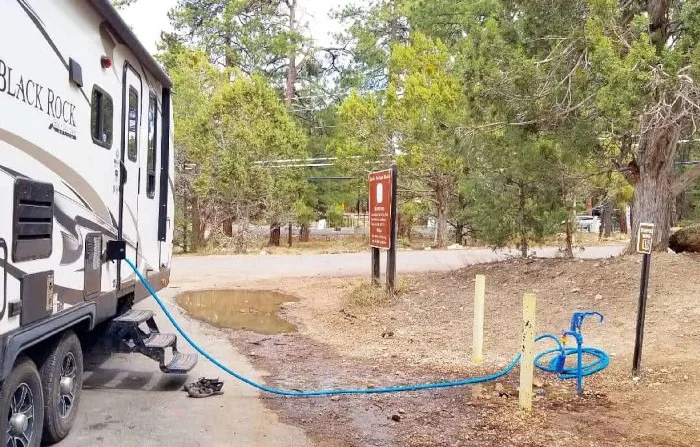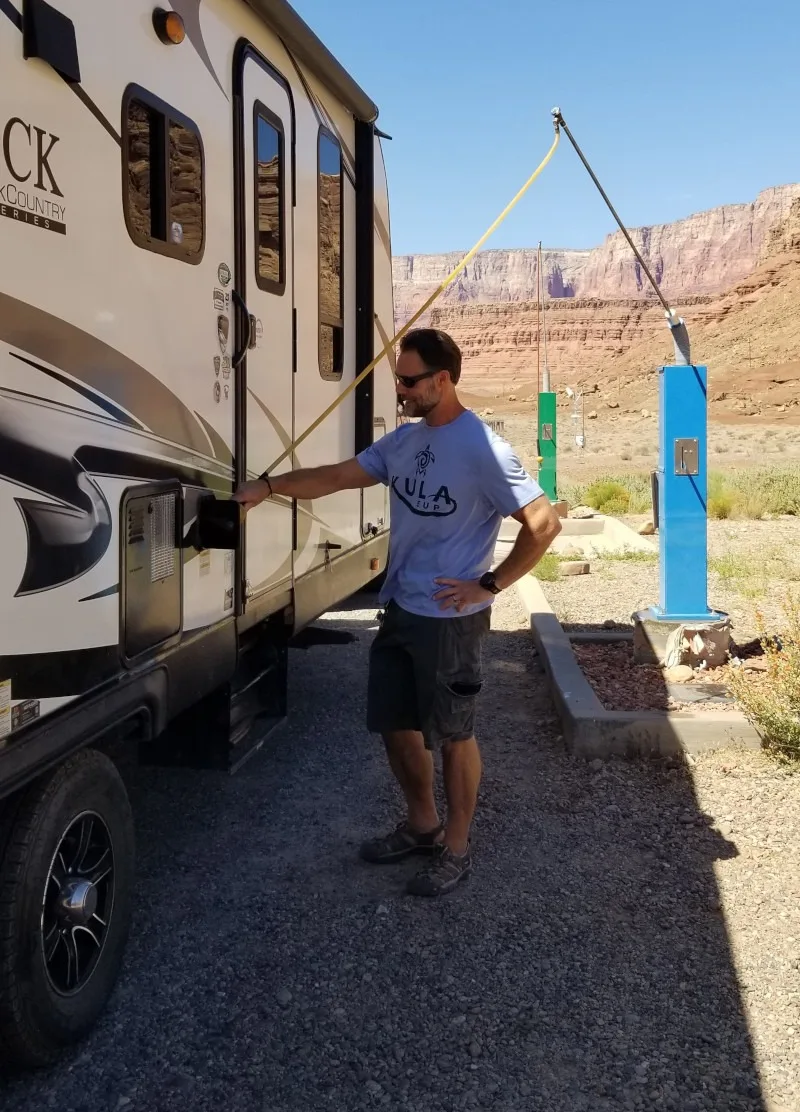Last Updated on 04/01/2024 by Glynn Willard
The first point to make is “why sanitize your fresh water tank and water lines in a camper?”
It’s simple. Clean water in your fresh tank is more than just a good idea!
There are many resources about how to sanitize your camper water system for good reason.
And for the most part, I haven’t seen any unrealistic sanitizing solution sold in stores that wouldn’t work.
But is it necessary to buy a commercially available RV water sanitizer product to sanitize your tank? Absolutely not!
Let’s look at my favorite tried and true method to keep your drinking water safe in your recreational vehicle.
What’s The Primary Goal For RV Water Tank Sanitization?
First and foremost, the elimination of pathogens in your RV’s plumbing system is the primary goal of the sanitizing process.
This is not about changing the flavor of your water, which you can do with either an inline filter, external water filter, or by filtering the water as you fill your fresh water tank.
We preferred the last of the three. We did this only to standardize the flavor of the water from different sources.
There are a lot of living organisms that can flourish in your freshwater tank regardless of how many gallons of water you have.
Some are harmless, some elicit foul odors and others can be downright dangerous.
Ask me how I know!
Therefore, killing the dangerous and odor-causing microorganisms is why we sanitize our camper’s fresh water tank.
How To Sanitize The Fresh Water Tank In An RV With A Bleach Solution
I’m specifically discussing the use of household bleach in this article.
This means a bleach you can acquire at the grocery store. You can obtain higher concentrations of a chlorine solution that are far more caustic elsewhere.
Do not use these. They lower the pH too much and can damage your entire system.
So, just stick to grocery store bleach with no additional additives or scents and you’ll be fine.
If you look closely, you’ll see most household bleach contains between 4.5% and 5.25% sodium hypochlorite.
That’s what RV owners should be looking for.
How Much Bleach Per Gallon Of Water To Sanitize Freshwater Tank?
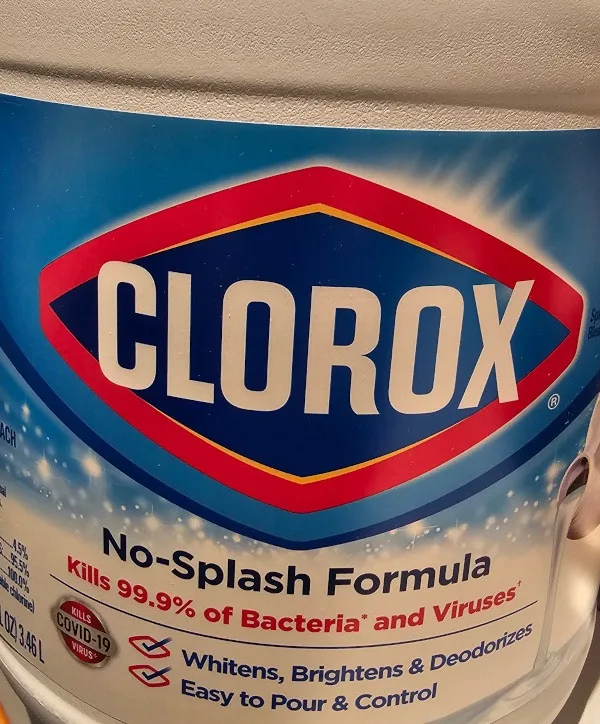
Your goal is a solution of water containing 50-200 ppm of bleach. I think closer to 200 is too much.
Side note. For you chemistry nerds out there, remember, if you’re not part of the solution, you’re part of the precipitate. I couldn’t resist!
If you want to be precise, use this site’s calculator.
First, look at your bleach to find the percentage.
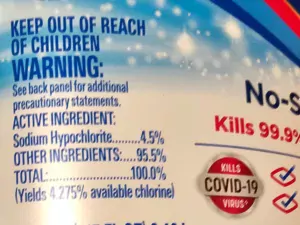
Then, on the calculator, enter the percentage, your desired ppm (50-200), the total volume of your fresh water tank, and your preferred metric output (gallons or liters).
If you don’t feel like using the calculator, here’s an example:
If you have a 50-gallon fresh water tank and you use a bleach containing 4.5% sodium hypochlorite and your goal is 100ppm, use the following amount of bleach:
1.9 cups of bleach for a 50 gallon tank.
You can round that up to 2 cups. And remember, that’s for 100ppm.
Suppose your freshwater tank is 25 gallons. Then add 1 cup of bleach (rounded up) to your freshwater holding tank.
Steps To Sanitize Fresh Water Tank In An RV
Sanitizing your fresh water is too easy to skip (and too dangerous to ignore) regardless of your city water source.
As stated before, your goal is a solution of between 50-200 ppm of sodium hypochlorite to eliminate dangerous microbes in your freshwater tank.
We’ve found 50-100ppm to work just fine and doesn’t overwhelm you with a strong bleach smell.
The Steps:
- Empty your fresh water tank. If you’re in an RV park, be discreet or ask for permission.
- Remove any inline filters. This is easy with canister-based filters. Simply unscrew, remove the filter, and replace the empty canister.
- Add the appropriate amount of bleach to the freshwater tank. I describe this above.
- Fill the fresh water tank with water just until it starts to overflow.
- Allow the bleach and water mixture to reside in your fresh water tank for 4 hours. It doesn’t need to sit for a long time. Technically, 30 minutes at 100 ppm is enough, but best to be safe.
- Manually bypass your hot water tank (heater).
- Draw the treated water through each water faucet with the water pump using both the cold faucets and hot water handles for 30-60 seconds.
This is why we bypassed the hot water heater. Don’t forget to run it through your outside shower. - After a total of four or more hours, dump the water from your fresh water supply tank.
- Refill the tank until it overflows and let it sit for a few minutes.
- Draw some of this water through all of your Pex lines in the RV water system to start flushing the bleach mixture out.
- Release the drain valve and dump the fresh water tank again after a few minutes.
- Refill the tank until it starts to overflow.
- Your final step is to draw water back through the faucets until the smell of bleach diminishes.
Your water is now safe to drink. If it still smells or tastes a little too much like bleached water, you can fill and drain the tank an additional time.
On a side note, I follow this same procedure for our Scepter 5-gallon jugs that we keep for emergencies.
A Few Points About Using Chlorine Bleach For Your Fresh Water Tank
Bleach is the best way to disinfect your freshwater system because:
- Bleach has been used as a water disinfectant for over 100 years.
- It’s very inexpensive and readily available.
- It has a very broad antimicrobial property. More so than hydrogen peroxide.
- Bleach is persistent in treating potable water.
- It’s easy to use.
- You’re not drinking the chlorinated water used for treatment.
- Bleach is not toxic at low concentrations to humans.
- The tiny amount of bleach that will make it into your gray tank and your black water tank will not offset the tank’s biome.
Alternatives To Bleach For RV Fresh Water Tank
A quick search on Amazon reveals a lot of bleach alternatives ranging in price.
You’re free of course to use whatever you feel suitable, but you can still safely accomplish the same thing with bleach for far less money.
And it takes very little time for the chlorine smell to dissipate from your RV’s fresh water system.
Hydrogen peroxide comes up a lot, but the cost is higher, it degrades faster and is not as pervasive at killing all the harmful bacteria and microbes.
How To Sanitize RV Fresh Water Tank When Fulltiming
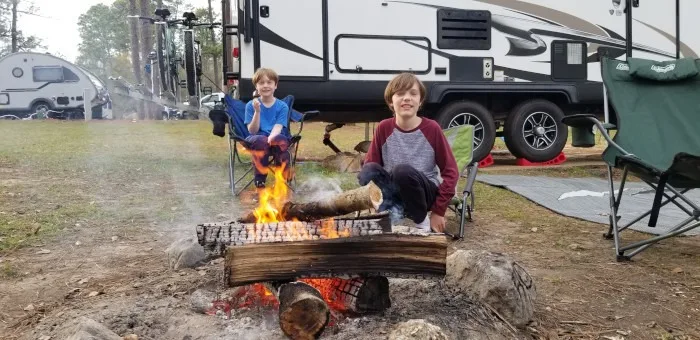
Sanitizing your RV’s fresh water tank at your home base is easy.
But what if you don’t have a home base? We solved this problem by booking a night at a campground or RV park.
A good time to do this is on a rainy day to dilute the smell and the impact on the environment.
I also advise you not to mention your intentions to the park’s management.
Is it environmentally friendly? No. Is it overwhelmingly bad for the environment? No.
But for the sake of our family’s health, some sacrifices are necessary.
Do I Need To Sanitize My Fresh Water Tank If I Filter My Water In An RV?
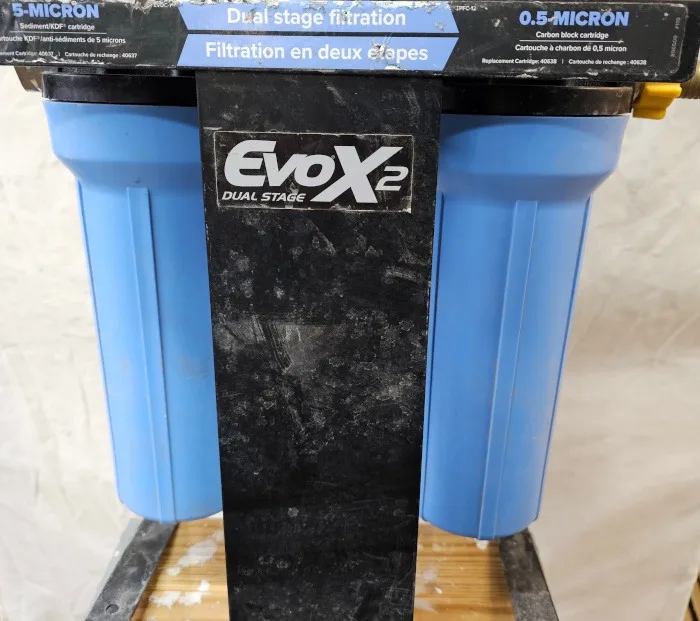
Yes, microbes still find their way into your tank.
Most filters do not remove some of the most harmful pathogens. If you have an inline UV-based filter, it will do the job.
But your tank may still develop a foul odor. So, this is another reason to treat your fresh water tank periodically or before your next camping trip.
How Often To Sanitize Fresh Water Tank In An RV?
This is a loaded question because it depends on your usage, if the RV was in storage, environmental temperatures, and whether it was ever filled with contaminated water.
We treated ours every 3-6 months depending on the environment where we lived.
As long as we maintained a 3-6 month consistent sanitization, we haven’t had any problems.
Wrapping Up Sanitizing Camper’s Fresh Water Tank
Sanitizing your camper’s water tank is crucial to eliminate harmful microbes and eliminate foul odors.
The least expensive way is to use regular household bleach. We’re talking pennies per treatment.
Figuring out the right amount of bleach to use for your RV’s tank can be determined with this calculator.
Remember, you’re looking for a 50-200ppm concentration of sodium hypochlorite to the total gallons of tank capacity.
Leave it sit for about four hours, dump it, and flush it several times and your camper’s water system will be sanitized for safe drinking.
How do you sanitize your RV’s freshwater tank?
Meet the author.
We appreciate any help in bringing you great content. Donate or buy us a coffee on our Ko-Fi site. Or subscribe to our YouTube Channel.
Thank you so much for being here!


